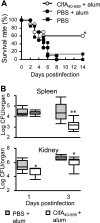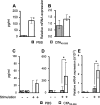Role of interleukin-17A in cell-mediated protection against Staphylococcus aureus infection in mice immunized with the fibrinogen-binding domain of clumping factor A
- PMID: 20679443
- PMCID: PMC2950370
- DOI: 10.1128/IAI.00447-10
Role of interleukin-17A in cell-mediated protection against Staphylococcus aureus infection in mice immunized with the fibrinogen-binding domain of clumping factor A
Abstract
Clumping factor A (ClfA) is a fibrinogen-binding cell wall-attached protein and an important virulence factor of Staphylococcus aureus. Previous studies reported that an immunization with the fibrinogen-binding domain of ClfA (ClfA(40-559)) protected animals against S. aureus infection. It was reported that some cytokines are involved in the pathogenesis of staphylococcal diseases and in host defense against S. aureus infection. However, the role of cytokines in the protective effect of ClfA(40-559) as a vaccine has not been elucidated. In this study, we demonstrated that the spleen cells of ClfA(40-559)-immunized mice produced a large amount of interleukin-17A (IL-17A). The protective effect of immunization was exerted in wild-type mice but not in IL-17A-deficient mice. IL-17A mRNA expression was increased in the spleens and kidneys of immunized mice after infection. CXCL2 and CCL2 mRNA expression was increased in the spleens and kidneys, respectively. Consistent with upregulation of the mRNA expression, neutrophils infiltrated into the spleens extensively and macrophage infiltration was observed in the kidneys of immunized mice. These results suggest that immunization with ClfA(40-559) induces the IL-17A-producing cells and that IL-17-mediated cellular immunity is involved in the protective effect induced by immunization with ClfA(40-559) against S. aureus infection.
Figures






Similar articles
-
IL-17A plays an important role in protection induced by vaccination with fibronectin-binding domain of fibronectin-binding protein A against Staphylococcus aureus infection.Med Microbiol Immunol. 2017 Jun;206(3):225-234. doi: 10.1007/s00430-017-0499-9. Epub 2017 Apr 4. Med Microbiol Immunol. 2017. PMID: 28378247
-
c-di-GMP as a vaccine adjuvant enhances protection against systemic methicillin-resistant Staphylococcus aureus (MRSA) infection.Vaccine. 2009 Jul 30;27(35):4867-73. doi: 10.1016/j.vaccine.2009.04.053. Epub 2009 May 9. Vaccine. 2009. PMID: 19406185
-
Preclinical Efficacy of Clumping Factor A in Prevention of Staphylococcus aureus Infection.mBio. 2016 Feb 2;7(1):e02232-15. doi: 10.1128/mBio.02232-15. mBio. 2016. PMID: 26838725 Free PMC article.
-
Demonstration of the preclinical correlate of protection for Staphylococcus aureus clumping factor A in a murine model of infection.Vaccine. 2015 Oct 5;33(41):5452-5457. doi: 10.1016/j.vaccine.2015.08.029. Epub 2015 Aug 28. Vaccine. 2015. PMID: 26319743
-
Protection against experimental Staphylococcus aureus arthritis by vaccination with clumping factor A, a novel virulence determinant.J Infect Dis. 2001 Dec 15;184(12):1572-80. doi: 10.1086/324430. Epub 2001 Dec 3. J Infect Dis. 2001. PMID: 11740733
Cited by
-
Novel synthetic (poly)glycerolphosphate-based antistaphylococcal conjugate vaccine.Infect Immun. 2013 Jul;81(7):2554-61. doi: 10.1128/IAI.00271-13. Epub 2013 May 6. Infect Immun. 2013. PMID: 23649092 Free PMC article.
-
Role of gamma-delta T cells in host response against Staphylococcus aureus-induced pneumonia.BMC Immunol. 2012 Jul 9;13:38. doi: 10.1186/1471-2172-13-38. BMC Immunol. 2012. PMID: 22776294 Free PMC article.
-
Interleukin-10 (IL-10) Produced by Mutant Toxic Shock Syndrome Toxin 1 Vaccine-Induced Memory T Cells Downregulates IL-17 Production and Abrogates the Protective Effect against Staphylococcus aureus Infection.Infect Immun. 2019 Sep 19;87(10):e00494-19. doi: 10.1128/IAI.00494-19. Print 2019 Oct. Infect Immun. 2019. PMID: 31358568 Free PMC article.
-
Targeted nasal vaccination provides antibody-independent protection against Staphylococcus aureus.J Infect Dis. 2014 May 1;209(9):1479-84. doi: 10.1093/infdis/jit636. Epub 2013 Nov 22. J Infect Dis. 2014. PMID: 24273045 Free PMC article.
-
Where does a Staphylococcus aureus vaccine stand?Clin Microbiol Infect. 2014 May;20 Suppl 5(0 5):66-75. doi: 10.1111/1469-0691.12570. Clin Microbiol Infect. 2014. PMID: 24476315 Free PMC article. Review.
References
-
- Bettelli, E., Y. Carrier, W. Gao, T. Korn, T. B. Strom, M. Oukka, H. L. Weiner, and V. K. Kuchroo. 2006. Reciprocal developmental pathways for the generation of pathogenic effector TH17 and regulatory T cells. Nature 441:235-238. - PubMed
-
- Domanski, P. J., P. R. Patel, A. S. Bayer, L. Zhang, A. E. Hall, P. J. Syribeys, E. L. Gorovits, D. Bryant, J. H. Vernachio, J. T. Hutchins, and J. M. Patti. 2005. Characterization of a humanized monoclonal antibody recognizing clumping factor A expressed by Staphylococcus aureus. Infect. Immun. 73:5229-5232. - PMC - PubMed
Publication types
MeSH terms
Substances
LinkOut - more resources
Full Text Sources
Other Literature Sources
Medical
Molecular Biology Databases

